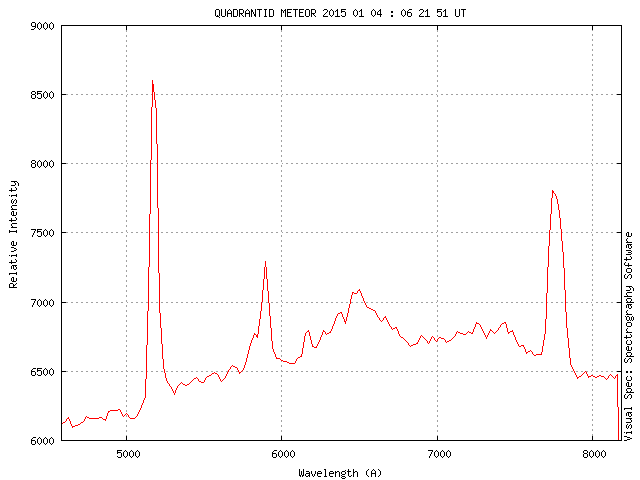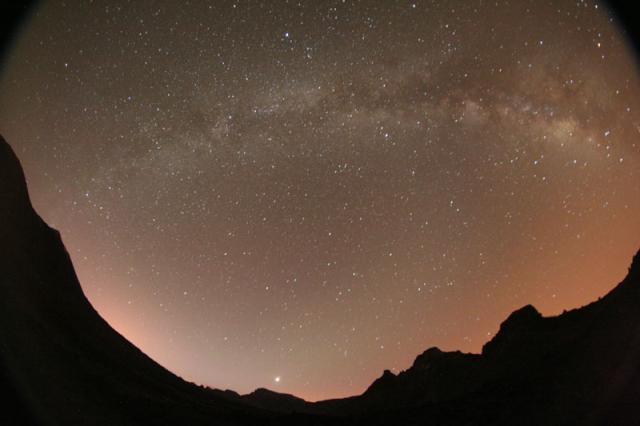Forum Replies Created
-
AuthorPosts
-
 Bill WardParticipant
Bill WardParticipantHi,
I find it remarkable that we can do disect the meteor so thoroughly!
My opening sentence should have been “…as weather AND moonlight permits.” It is a significant problem, the gratings are designed to diffract light afterall. It’s just they do is so well in some un-desired circumstances 😉
Mmm, the daD shower is an interesting option, just goes to show the possibilities.
Yes, I had the same idea regarding the Vg. Is this included in the log files that Capture generates for passing to Orbit? Or is it dervied from multiple stations in Orbit? I am clearly out of touch with the subtleties of multi station work. I’ll check the file tonight as that would clinch it. Do you have any Vg values for the daD?
Utterly fascinating.
Cheers,
Bill.
 Bill WardParticipant
Bill WardParticipantHi,
Thanks Alex, That’s the plan. I have one on bearing 130 at ~45 deg as weather permits.
Back to the Quadrantids, I did record several others, all fainter and one through considerable cloud. When processing them I noticed something of (possible) significance.
Consider:




These are the synthetic spectra of 4 Quadrantids.
Q1 is of the first post. Q2, Q3 and Q4 were the fainter ones.
Note: I have made no attepmt to align the lines in this case. They were all captured with the same 300 groove/mm grating. Due to varying angles with respect to the dispersion axis it looks like they have different dispersions (the lines at varying distances from one another) this is a geometric effect caused by the re-orientation process. The physical dispersion is the same in all.
Now, it is apparent that Q2, Q3 and Q4 have the green Magnesium (~518nm) line brighter than the yellow Sodium (~590nm) line. With Q1 it is a bit difficult to tell. This is where the graphs now have to come into play.
So,




The graphs are in the same order. It is clear that Q1 is the only one where the Magnesium line (518nm) is lower than the Sodium line (590nm).
(Worthy of a “Ta Dah!” at this point, perhaps)
So does this mean that Q1 was not a Quadrantid, I’m not sure. (I don’t think anyone would be either) A, presumably, slightly larger meteoroid would experience different heating and stress which could conceivably result in a different emission profile.
However, it could be that Q1 was not a Quadrantid afterall and merely was coincidental on the sky with respect to the radiant.
A Quadran Muralis mystery….cheers,
Bill.
 Bill WardParticipant
Bill WardParticipant….and growing….
Another nice fireball spectrum.This is getting towards the highest resolution meteor spectrum taken using the WATEC generation of video cameras.
A 600 groove/mm fused silica grating but the meteor was caught in the second order so roughly equivalent of a 1200 groove/mm grating in the first order. The double line at the sodium wavelength is genuine. It can be seen evolving in the video but I haven’t been able to identify what it is (yet) The system resolution, even in the second order, doesn’t have the ability to split the sodium doublet so it’s not that. Another interesting meteor mystery!

Fireball 2014 12 28 : 0450UT
Cheers,
Bill.
28 December 2014 at 9:48 pm in reply to: PHEMU – 2014 Dec 24 – Europa (II) eclipsed Ganymede (III) #576724 Bill WardParticipant
Bill WardParticipantHi,
That is pretty slick work Alex.
An excellent result!
cheers,
Bill.
 Bill WardParticipant
Bill WardParticipantNow for a plain old iron meteor….
With the exception of a couple of magnesium lines these are all probably iron lines.

Meteor 2014 04 19 : 235419UT
The family tree is growing….
 Bill WardParticipant
Bill WardParticipantHi,
Been working through some more spectra. This one looks really nice in the blue. Mostly Iron (Fe) lines here with some additional weak Magnesium lines in the near UV. Taken on 2014 11 15 : 051157UT but using a 300 groove/mm grating. However this shows the effect of “good” geometry even at relatively low dispertions. Looks like a stony iron sporadic.

Cheers,
Bill.
 Bill WardParticipant
Bill WardParticipantHi William,
The size, that is span of wavelength, is just a consequence of what bit of the spectrum was in the field of view.
The actual dispersion is the same. The sporadic fireball was a bullseye. It went across the fov slightly diagonally but dead centre. So the whole range of the (silicon) detector was utilised and a full range spectrum was caught, from the UV cut off of the glass to nearly the edge of the silicon “band gap” at just over 1000nm. Actually that was a remarkably lucky catch!
You have a greater chance of catching the whole spectrum if one uses a lower dispersion grating. But then the resolution drops, it’s all a compromise.
cheers,
Bill.
 Bill WardParticipant
Bill WardParticipantHi,
Poor weather washed out the peak night sadly but the night before had 8 1/2 hours clear and the night after about 6 1/4 hours mostly nclear with some cloud and showers.
A decent haul and some nice captures but only one useable Geminid spectum. It shows a very prominent magnesium line (left most large peak) and a lesser sodium line. The other fainter lines are also magnesium and iron.
Cheers,
Bill.

 Bill WardParticipant
Bill WardParticipantHi,
It’s on that road but it’s 5-6 miles away in the direction of Venus in the picture, just shows how big the crater/caldera is!
 Bill WardParticipant
Bill WardParticipantForgot to add, I put this picture on the Meteor Observers Forum too. Shows what the difference in latitude makes. Taken at 0506UT on the morning of the 6th May.

 Bill WardParticipant
Bill WardParticipantHi Alex,
I had three great night observing from Tenerife and my total amounted to 6 eta aquarids! Not a great amount but it least it was a good break. Lovely weather down at sea level and beautiful skies higher up.
Interestingly whilst travelling to and from the location I use I saw several groups (with mini busses in layby’s) using telescopes and binoculars. Seems as though the “astro tourism” trade is really taking off.
cheers,
Bill.
 Bill WardParticipant
Bill WardParticipantHi,
When is a Lyrid not a Lyrid? when you discover you actually caught it on another camera and it doesn’t go through the radiant!
A salutory reminder of the perils of visual observing, even with bright (this was -2/-3) meteors great care must be taken. Looks like this is a rather unique (spectrally) sporadic.
So no Lyrids after all. A total of 43hours 10 mins (times two for two cameras + some CCD time), oh well roll on the Eta Aquarids….
cheers,
Bill.
-
AuthorPosts
